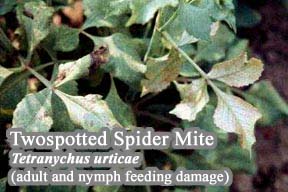Coleus (Coleus)
Plant Health Problems
Diseases caused by Nematodes:
Foliar nematodes, Aphelenchoides.
These plant-parasitic worms attack virtually all plant parts and discolored
spots appear on the leaves, starting first from the underside and gradually
involving the entire leaf. Lower leaves first show brown wedge-shaped areas
between the veins which eventually involve the entire leaf. Discoloration then
progresses from the bottom to the top of the plant. The nematodes live and move
in water films.
Reducing leaf moisture by avoiding overhead irrigation and removal of infected
tissues, debris, or plants are all important to minimizing the impact of this
disease.
Insect Problems:
Leaf crinkle.
Leaves may be crinkled, thickened and distorted by cyclamen mites. Cyclamen
mite Phytonemus pallidus is a translucent, microscopic mite that
often infests the new leaf and blossom buds, and can proliferate on spent
blossoms. Characteristic injury includes dwarfed, thickened and wrinkled
leaves. On azalea, dahlia, and other plants with stems, the distance between
internodes becomes drastically shortened. Infested plants do not bloom, or
blossoms may be misshapen. Cyclamen mite is not easily controlled when mature
plants are badly infested: effective miticides are not available to homeowners,
so a commercial applicator may be required for effective miticide applications.
Effective restricted use products include abamectin, dicofol, and
endosulfan.
Greenhouse orthezia, Orthezia insignis.
This is a dark-green or brown scale-like insect that secretes wax as it feeds,
leaving behind a long plate of white wax. It damages plants by withdrawing sap.
When needed, malathion, which is among the compounds registered for control of
this pest in Connecticut, can be applied according to label directions.
Greenhouse whiteflies, Trialeurodes vaporariorum.
The greenhouse whitefly, Trialeurodes vaporariorum, the sweetpotato
whitefly, Bemisia tabaci, and silverleaf whitefly, Bemisia
argentifolii, commonly infest coleus under glass and are often carried into
the field where they may persist. The life cycles of these species are similar.
The tiny, white moth-like adult has a mealy appearance due to the small
particles of wax that it secretes. It lays groups of eggs on the underside of
leaves. The eggs hatch into small oval crawlers, which then settle down and
become scale-like nymphs that suck sap from stationary locations on the leaves.
These then spend about 4 days in an immobile pupal stage before becoming
adults. About 5 weeks are required to complete the life cycle in the
greenhouse.
Yellow sticky traps are an effective way to monitor populations of whiteflies, and may even be attractive enough to reduce minor infestations. Biological controls can also be effective against whiteflies, especially in a greenhouse environment. The predatory ladybeetle, Delphastus pusillus, specializes in whiteflies and feeds on all three whitefly species. The parasitoid, Encarsia formosa, can control the greenhouse whitefly, but not the other species, in the greenhouse. Another parasitoid, Eretmocerus californicus, attacks all three species and can assist in controlling minor infestations in the greenhouse. Insecticidal soap or ultra-fine horticultural oil, which are among the compounds registered for control of this pest in Connecticut, sprayed on the undersides of leaves, can be used against whiteflies in the greenhouse or the field. When applied at a low, half-percent concentration, soap is selectively toxic to whiteflies rather than parasitic wasps. Azadiractin (neem), also directed to the undersides of the leaves, can also be used. Repeat applications of sprays will probably be needed because some stages in the life cycle are dormant and not affected by insecticides or other sprays. Alternatively, imidacloprid, applied as a systemic to be taken up by the roots, will provide season-long control. Consult the label for dosage rates and safety precautions. Chemical control using conventional insecticides is difficult because of widespread insecticide resistance.
Mealybugs, Planococcus citri.
Coleus plants in greenhouses are very susceptible to infestation by mealybugs.
White cottony masses appear on leaf surfaces, in leaf axils and sheaths. These
insects damage plants by sucking plant sap. Among the compounds registered for
control of this pest in Connecticut are insecticidal soap, ultrafine
horticultural oil, microencapsulated diazinon, or resmethrin. These products
are most effective against crawlers. Because of overlapping life stages in a
home environment, multiple applications will be needed to control this pest.
Spray needs to contact the insect. Alternatively, imidacloprid, applied as a
systemic to be taken up by the roots, will provide season-long control. Consult
the label for dosage rates and safety precautions.
 Twospotted spider mite, Tetranychus urticae.
Twospotted spider mite, Tetranychus urticae.
This is a serious pest of coleus. It infests the undersides of the leaves,
which become light yellow in color, and the plants have a generally unhealthy
appearance. Sometimes the mites form webs, which more or less enclose the upper
as well the lower leaf surface. Among the compounds registered for control of
this pest in Connecticut are insecticidal soap and ultrafine horticultural oil.
Spraying with insecticidal soap will give sufficient control if applied at
least twice at 7-10 day intervals. The predatory mite, Neoseiulus fallacis,
is most commonly found feeding where there are mite infestations. A single
application of ultrafine horticultural oil (1/2 to 1% dilution) can be
effective if predatory mites are present. Special care should be taken with
soap or oil to obtain thorough spray coverage, because they only work on
contact. Abamectin is an effective restricted use product. Consult the label
for dosage rates and safety precautions. Avoid applying carbaryl or
pyrethroids, which tend to be much more toxic to the predators than to the pest
spider mites.

